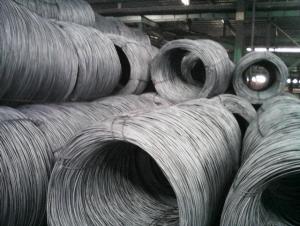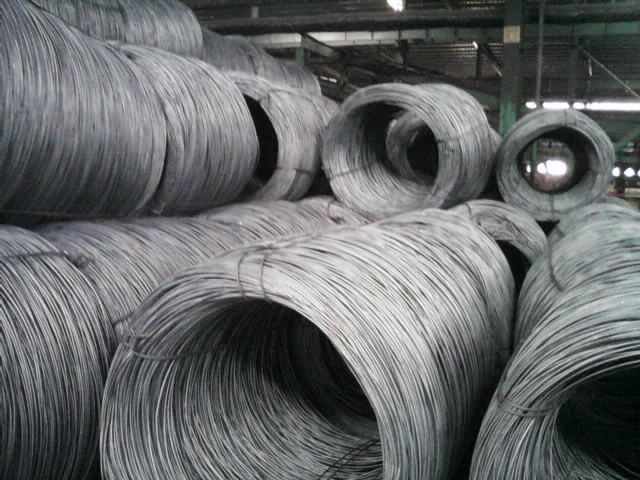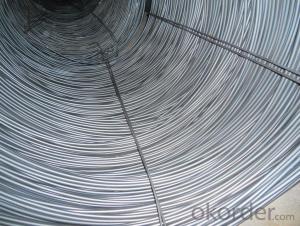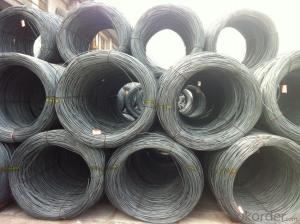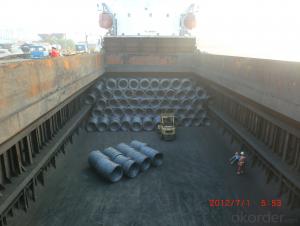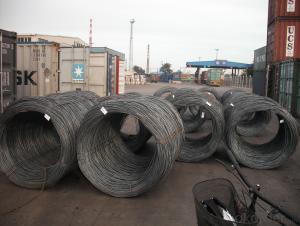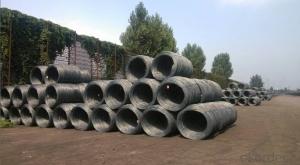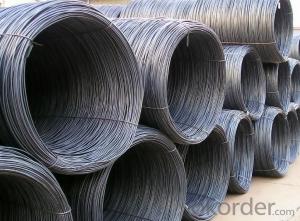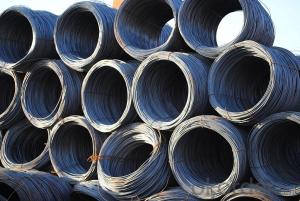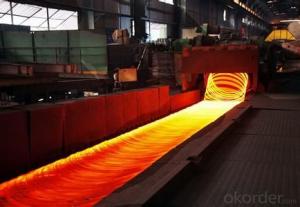Hot Rolled Carbon Steel Wire Rod High Quality
- Loading Port:
- China Main Port
- Payment Terms:
- TT or LC
- Min Order Qty:
- -
- Supply Capability:
- -
OKorder Service Pledge
OKorder Financial Service
You Might Also Like
Product Description:
OKorder is offering Wire Rod at great prices with worldwide shipping. Our supplier is a world-class manufacturer of steel, with our products utilized the world over. OKorder annually supplies products to European, North American and Asian markets. We provide quotations within 24 hours of receiving an inquiry and guarantee competitive prices.
Product Applications:
After hot-rolled the products shaped into coil and delivery as finished product, including round, square, rectangular, hexagonal and so on. Since most of the products are round, it is generally called wire rod. Carbon steel wire rod is widely used in construction and manufacturing. Carbon steel wire rod is mainly used for reinforcement of reinforced concrete and welded structure or reprocessed (roberts , nail, etc.) materials, especially used to produce wire drawing, welding electrode, nails, spring, electronic, precise machinery parts and so on.
.
Product Advantages:
OKorder's Wire Rod are durable, strong, and resist corrosion.
Main Product Features:
· Premium quality
· Prompt delivery & seaworthy packing (30 days after receiving deposit)
· Corrosion resistance
· Can be recycled and reused
· Mill test certification
· Professional Service
· Competitive pricing
Product Specifications:
Steel Grade: Q195/235, SAE1006-1018B Standard: ASTM, GB
Diameter: 5.5mm, 6.5mm, 7mm,8mm,9mm,10mm,12mm,14mm
Type: in coil, coil weight around 2MT Alloy or Not: Alloy
Surface: round, no twisted, light and smooth Chemical Composition: (Please kindly find our chemistry of our material based on Q195、Q235A and Q235B as below for your information)
Trademark | Rank | Chemical composition (quality score) % | |||||
C | Si | Mn | S | P | |||
| ≤ |
| ≤ | ≤ | |||
Q195 |
| 0.06-0.12 | 0.30 | 0.25 | 0.050 | 0.045 | |
Q235 | A | 0.14-0.22 | 0.30 | 0.30-0.65 | 0.050 | 0.045 | |
Q235 | B | 0.12-0.20 | 0.30 | 0.30-0.70 | 0.045 | 0.045 | |
Trademark | Rank | Pulling Test | |||||
Bend PointΔs/Mpa | Tensile Strength | Elongation Ratioδ5% | |||||
Thickness (Diameter) /MM | Thickness (Diameter) /MM | ||||||
≤16 | 16-40 | ≤16 | 16-40 | ||||
≥ | ≥ | ||||||
Q195 |
| 195 | 185 | 315-390 | 33 | 32 | |
Q235 | A | 235 | 225 | 375-500 | 26 | 25 | |
Q235 | B | 235 | 225 | 375-500 | 26 | 25 | |
FAQ:
Q1: Why buy Materials & Equipment from OKorder.com?
A1: All products offered byOKorder.com are carefully selected from China's most reliable manufacturing enterprises. Through its ISO certifications, OKorder.com adheres to the highest standards and a commitment to supply chain safety and customer satisfaction.
Q2: How do we guarantee the quality of our products?
A2: We have established an advanced quality management system which conducts strict quality tests at every step, from raw materials to the final product. At the same time, we provide extensive follow-up service assurances as required.
Q3: What makes stainless steel stainless?
A3: Stainless steel must contain at least 10.5 % chromium. It is this element that reacts with the oxygen in the air to form a complex chrome-oxide surface layer that is invisible but strong enough to prevent further oxygen from "staining" (rusting) the surface. Higher levels of chromium and the addition of other alloying elements such as nickel and molybdenum enhance this surface layer and improve the corrosion resistance of the stainless material.
Images:
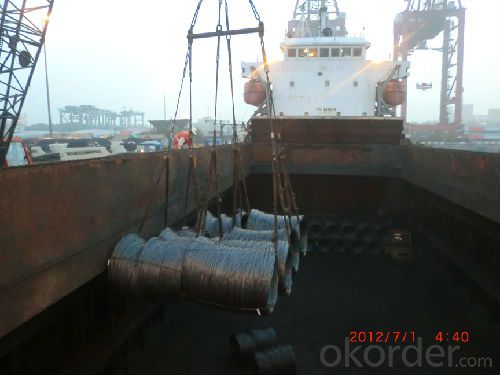
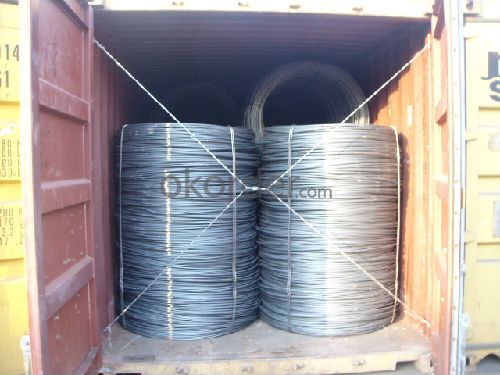
- Q: What are the different types of steel wire rod surface defects after wire drawing?
- There are several types of surface defects that can occur on steel wire rods after the wire drawing process. These defects can be classified into various categories based on their appearance and causes. 1. Scratches: Scratches are linear marks on the surface of the wire rod that can occur during the drawing process. They are typically caused by abrasive particles or contact with sharp edges of the drawing dies. 2. Scale: Scale refers to the thin layer of oxide that forms on the surface of the wire rod during the heating and rolling processes. It can create a rough and uneven surface, affecting the wire rod's appearance and performance. 3. Pitting: Pitting defects appear as small depressions or pits on the surface of the wire rod. They are typically caused by localized corrosion or uneven cooling of the wire rod during the manufacturing process. 4. Flakes: Flakes are irregularly shaped, thin pieces of metal that detach from the surface of the wire rod. They are often caused by excessive friction between the wire rod and the drawing dies, leading to material detachment. 5. Decarburization: Decarburization occurs when the carbon content in the steel wire rod reduces on the surface due to exposure to high temperatures during the manufacturing process. This can result in a weakened structure and reduced mechanical properties. 6. Laps: Laps are irregularities on the surface of the wire rod that occur due to folding or overlapping of the material during the drawing process. They can weaken the wire rod's structure and lead to premature failure. 7. Grooves: Grooves appear as deep, narrow channels on the surface of the wire rod. They can be caused by uneven wear of the drawing dies or abrasive particles present during the drawing process. 8. Coating defects: In some cases, wire rods may have a coating applied to protect against corrosion. Coating defects can include peeling, blistering, or uneven application, which can compromise the corrosion resistance of the wire rod. It is important to note that these defects can affect the quality and performance of the wire rod. Manufacturers often employ various quality control measures and inspections to identify and address these defects to ensure the production of high-quality wire rods.
- Q: How are steel wire rods used in the manufacturing of wire baskets for storage?
- Steel wire rods are an essential component in the manufacturing of wire baskets for storage. These rods serve as the base material from which the wire baskets are formed. They are typically made from high-quality steel, ensuring durability and strength in the final product. To begin the manufacturing process, the steel wire rods are first cleaned and then straightened to remove any bends or twists. This step is crucial to ensure that the wire baskets are formed with precision and accuracy. Once the wire rods are straightened, they are fed into a wire drawing machine. This machine gradually reduces the diameter of the rods, resulting in thinner wires. These thinner wires are then coiled onto large spools, ready to be used in the construction of wire baskets. The next step involves forming the wire rods into the desired shape for the wire baskets. This is achieved through a process called wire forming, where the wires are bent and manipulated using specialized machinery. The wire rods are carefully shaped to create the frame and mesh structure of the wire baskets. After the wire rods are formed into the desired shape, they are welded together at the joints to ensure stability and strength. Welding is crucial to ensure that the wire baskets can withstand the weight of the items stored within them. Once the welding process is complete, the wire baskets undergo a finishing process. This may include surface treatments such as galvanization or powder coating to enhance their resistance to corrosion and improve their aesthetic appearance. In conclusion, steel wire rods play a crucial role in the manufacturing of wire baskets for storage. They provide the strength and durability required for these baskets to withstand heavy loads and ensure longevity. Without steel wire rods, it would be impossible to create wire baskets that are suitable for storage purposes.
- Q: What are the different ductility testing methods for steel wire rod?
- There are several ductility testing methods available for steel wire rod. These methods are used to measure the ability of the material to deform under tensile stress without breaking. Some of the common ductility testing methods for steel wire rod include the following: 1. Tensile Test: This is the most common method used to assess the ductility of steel wire rods. In this test, a specimen of the wire rod is subjected to a gradually increasing tensile force until it breaks. The elongation and reduction in area of the specimen are measured, which provide valuable information about the ductility of the material. 2. Bend Test: This test involves bending a specimen of the wire rod to a specified angle without causing any cracks or fractures. The ability of the material to withstand bending without breaking indicates its ductility. The angle of bending and any visible defects are recorded to evaluate the ductility properties. 3. Cupping Test: This test is performed to determine the deep-drawing quality of steel wire rods. A specimen is placed over a die and a punch is used to deform it into a cup shape. The ability of the material to undergo deformation without cracking or tearing indicates its ductility. 4. Charpy Impact Test: While primarily used to measure the toughness of materials, the Charpy impact test is also indicative of the ductility of steel wire rods. In this test, a notched specimen is subjected to a high-velocity impact from a swinging pendulum. The energy absorbed during fracture is measured, and if the material exhibits high energy absorption, it suggests good ductility. 5. Fatigue Test: This test is used to assess the fatigue resistance of steel wire rods, which indirectly indicates their ductility. The specimen is subjected to repeated cyclic loading, and the number of cycles required for failure is recorded. A material with high ductility is expected to have better fatigue resistance. These testing methods provide valuable information about the ductility properties of steel wire rods, helping engineers and manufacturers select the appropriate material for specific applications.
- Q: What are the common production processes for oxygen-coated steel wire rod?
- The common production processes for oxygen-coated steel wire rod include cleaning the wire rod to remove any impurities, applying a thin layer of oxygen coating to enhance corrosion resistance, and then drying and cooling the coated wire rod before it is ready for further processing or usage.
- Q: What are the different corrosion resistance properties of steel wire rod?
- The corrosion resistance properties of steel wire rod can vary depending on factors such as the composition of the steel, the presence of protective coatings or finishes, and environmental conditions. Some types of steel wire rod, such as stainless steel, exhibit excellent corrosion resistance due to high levels of chromium and other alloying elements. These types of steel are particularly resistant to rust and corrosion caused by moisture or exposure to corrosive substances. On the other hand, carbon steel wire rod may have lower corrosion resistance and may require additional protective measures, such as galvanization or coating, to prevent corrosion. Overall, the corrosion resistance properties of steel wire rod can range from high to low depending on the specific type of steel and the conditions it is exposed to.
- Q: How is steel wire rod used in the manufacturing of wire forms for transportation vehicles?
- Steel wire rod is used in the manufacturing of wire forms for transportation vehicles as it provides strength, durability, and flexibility. It is commonly used to create various wire components such as springs, cables, and reinforcements, ensuring the structural integrity and safety of vehicles. The steel wire rod is shaped, bent, and formed into specific designs and sizes, allowing it to be utilized for various applications in transportation vehicles, such as seat frames, suspension systems, and safety features.
- Q: What are the common sizes of steel wire rod?
- The common sizes of steel wire rods vary depending on the specific application and industry requirements. However, some commonly used sizes of steel wire rods include diameters ranging from 5.5mm to 20mm. These sizes are typically used in the manufacturing of various products such as wire ropes, springs, nails, screws, and reinforcement bars for construction purposes. Additionally, steel wire rods can also be found in larger diameters, exceeding 20mm, for heavy-duty applications like prestressed concrete structures and suspension bridges. It's important to note that the sizes of steel wire rods can vary by region and specific industry standards, so it's always advisable to consult the relevant specifications and standards for accurate information.
- Q: What are the common production processes for lead-coated steel wire rod?
- The common production processes for lead-coated steel wire rod typically include wire drawing, cleaning and pickling, lead coating, and final inspection.
- Q: How is steel wire rod used in the manufacturing of wire for automotive fuel injection systems?
- Steel wire rod is used in the manufacturing of wire for automotive fuel injection systems as it provides the necessary strength and durability required for this critical application. The wire rod is first processed through various stages such as drawing and annealing to achieve the desired diameter, surface finish, and mechanical properties. This wire is then further processed and formed into intricate shapes and components, such as fuel injector springs, connectors, and terminals, which play a vital role in ensuring efficient fuel delivery and system performance.
- Q: How is steel wire rod tested for impact resistance?
- Steel wire rods are tested for impact resistance through a standardized procedure known as Charpy or Izod test. In this test, a notched sample of the wire rod is placed in a pendulum impact tester. The pendulum is then released, striking the sample and causing it to fracture. The energy absorbed during fracture is measured, indicating the material's resistance to impact. This test helps determine the robustness and durability of the steel wire rod in various applications.
Send your message to us
Hot Rolled Carbon Steel Wire Rod High Quality
- Loading Port:
- China Main Port
- Payment Terms:
- TT or LC
- Min Order Qty:
- -
- Supply Capability:
- -
OKorder Service Pledge
OKorder Financial Service
Similar products
Hot products
Hot Searches
Related keywords
